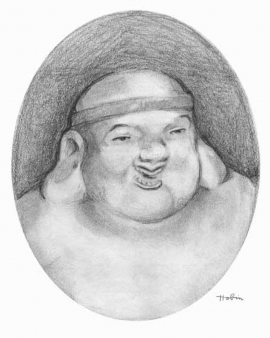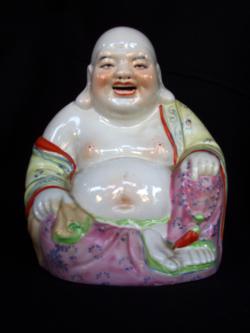August 14, 2014
 Ong Dia by James HobinHowever much we in Dorchester may strive to achieve spiritual bliss, we also must struggle with the challenge of living in an urban environment, which can be frustrating at times. The way to contentment is learning to live in harmony with your environment.
Ong Dia by James HobinHowever much we in Dorchester may strive to achieve spiritual bliss, we also must struggle with the challenge of living in an urban environment, which can be frustrating at times. The way to contentment is learning to live in harmony with your environment.
But how is this to be accomplished when all too often a thing that is a vital necessity for one person is nothing more than an annoying inconvenience for another? Some people turn to religion to gain acceptance and to reconnect with their neighbor. Churches all over Dorchester are helping people to do this every day.
Some 20 years ago, a Buddhist temple was established on Park Street in Fields Corner. Built by Vietnamese Buddhists now living in Dorchester, the name of the temple is Luc Hoa, which means “six elements,” as in the “Six Elements of Happiness.”
I looked up the “Six Elements of Happiness” on Wikipedia, and “wealth” was not listed there. Twenty-five hundred years ago, Prince Siddhartha renounced earthly riches to become Buddha and bring about a major religion based on simplicity.
Another word not included is “luck.” Buddhists put no faith in luck. However, in Vietnamese culture there is a character who is revered as the patron saint of luck, even though he has nothing at all to do with religion. His name is Ong Dia, or, “Mr. Earth.”
I learned all this while making a casual survey of Ong Dia altars found in places of business along Dorchester Avenue. Perhaps you have seen one of them in stores operated by Vietnamese business people. The altar looks like a little house in which sits Ong Dia, a happy-looking, chubby bald man with enormous earlobes who is not to be mistaken for a Buddha. Actually, Ong Dia is more like our own Santa Claus, a fairy tale hero who brings you lots of good things, and for free.

You don’t have to go into a store to see an Ong Dia altar because they are situated to be visible from the street. Ong Dia always faces the door and is placed there to attract customers. Some altars include a plastic wide-eyed golden kitty that stands upright and waves passersby inside with a battery-driven, plastic golden paw that swings back and forth.
Recently, I went into a drug store on Dorchester Avenue and asked the pharmacist for permission to photograph the Ong Dia altar on display there. After listening to my question, the pharmacist paused a moment, then leaned toward me and confided in a low voice, “That is Mister Earth.” The pharmacist drew out the “r” in “earth” to make a sound like a whirring motor. Then, extending one arm forward, he swept a hand through the air just above the floor between us, “Mister Earth is always on the ground,” he said.
Buddha statues are placed on high while the Ong Dia statue is set on the ground because Ong Dia is concerned with material things. Ong Dia looks comfortable, well fed, and prosperous. The pharmacist explained to me that the altar brings good luck to the store patron as well as to the storeowner. “The altar is for everybody,” he said, “it is an invitation for a person to think well, which leads a person to do well.”
This drug store’s Ong Dia altar is about sixteen inches tall, painted red and gold, and constructed to look like a pagoda. A railing with two gold lions opens onto a porch where the ceramic statue of Ong Dia is placed. His face is set in laughter and he is wearing a loose-fitting red robe with matching red headband. Columns intertwined with dragons support the roof of the porch, and over the roof there are more dragons, and jumping fish.
An image of a bearded man seated on a throne is fixed to the back panel, and in the front, two electric candles flank a plastic vessel containing three plastic incense sticks, each with a tiny electric bulb at the tip. On this day, there was an offering of food: a plate with two apples, a pastry in a wax paper napkin, and a fresh sandwich wrapped with an elastic band.
It should come as no surprise that the shiniest and most lavish altars did not by any means guarantee the best hospitality. In fact, as I made my way down the avenue, popping into stores unannounced and snapping photos, one of the kindest receptions I received came from the store with the humblest altar of them all.
Like the videos and CDs in which the store specialized, it was covered in dust. “My wife usually tends to this,” the proprietor said as he lit a stick of incense and set it into a small, sand-filled bowl that was already packed with burnt-out stubs. “You won’t see these altars everywhere,” he continued. “It’s a way to build karma. The young people are not interested. Like the CDs that we sell, only old people are interested in the altars,” he said.
Karma involves cause and effect, an idea that originated before Buddhism. Buddhism is an old religion but it is not about the past or the future. For Buddhists, the focus is on today and karma is now. Buddhists in Dorchester built the Luc Hoa Temple to create harmony; that is good karma, not good luck.
Traditionally, Buddhist temples conduct services on the first day of the month and the day of the full moon. But in order to accommodate the realities of American life, services at the Luc Hoa Temple are held on Sunday evenings instead. The shift in schedule is an example of the principle of nonresistance that is central to Buddhism. The community and its individual members are willing to change to try to find harmony.
Buddha showed that creating harmony is possible by simply seeing things from a different perspective. Take a moment and try to understand another person’s point of view. Doing this might not make you a Buddhist, but it certainly will make you more Buddha-ful.
With Special thanks to Nam Van Pham
Villages:


